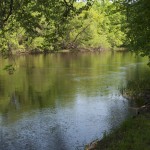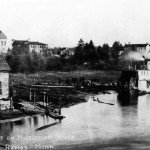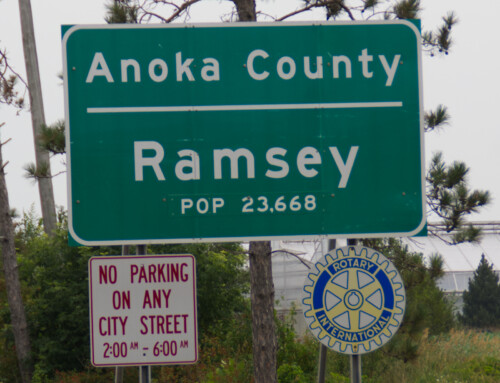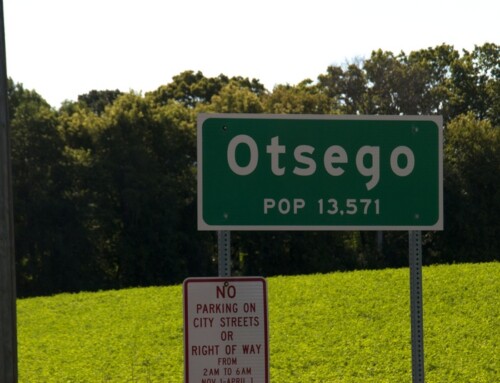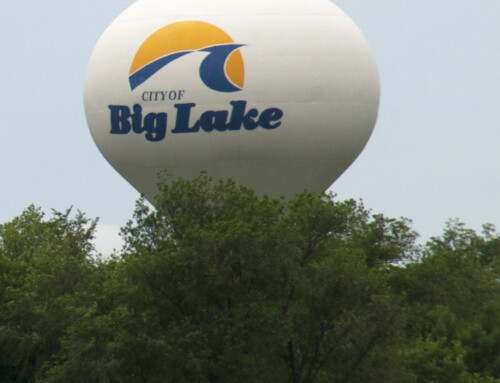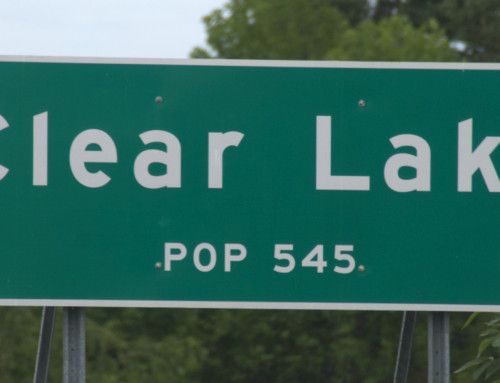Visitor Information
Direct your questions to the Aitkin Area Chamber of Commerce (301 Minnesota Ave. N; 218.927.2316).
History
Aitkin owes it early growth to the logging industry. When it was founded in 1871 (when the Great Northern Railroad built a station here), it was the northern-most settlement on the Mississippi River. The town’s primary industry was supplying the nearby logging camps which housed upwards of 2,000 men. All those men needed a place to relax, which explains why the small city had over a dozen saloons and several brothels in the early years. For about forty years, an average of 226 million board feet of lumber moved down the Mississippi past Aitkin, peaking in 1904 at 500,000,000 board feet before ending just six years later as the forests were depleted.
The city is named for William Alexander Aitkin (1785-1851), a man of Scottish descent who worked his way down from Canada in the early 1800s to work in the fur trade. Aitkin was, by all accounts, a man well-adapted to life as a backwoodsman, even though his family in Scotland seemed quite worried about his well-being in the wilderness (he was from the big city of Edinborough). By 1831 he was put in charge of an American Fur Company trading post at the confluence of the Sandy and Mississippi Rivers. After his post was sold, Aitkin had a dispute with his new bosses and got fired in 1838, so he set up a rival post. When Aitkin died in 1851 (he was probably in his early 60s), he left behind at least two dozen children. He had been married at least 6 times, all to women from American Indian tribes.
James Warren Tibbets was one of the first settlers, getting started with a 160-acre homestead grant after the Civil War. He served as the first sheriff and the first postmaster. He and his family was quite hospitable; they often provided temporary lodging at their house for men who were making their way to a logging camp. It wasn’t always an ideal place to live, though; one summer he had to send his family to live in Elk River because the mosquitoes were so bad in Aitkin.
The Mississippi River in this area meanders through the bed of glacial Lake Aitkin; the distance from Grand Rapids to the City of Aitkin is less than 50 miles as the crow flies but if you travel by the Mississippi, you’ll cover 120 miles. Fifty years of regular steamboat service began on this route in 1871 with the sternwheeler Pokegama. The steamboats primary mission was to supply the area’s logging camps, but they also provided passenger service; the route had 25 regular stops but locals could flag down a boat at any point. There wasn’t much river traffic downriver of Aitkin, just occasional trips to Brainerd or Pine River.
The area has always been prone to flooding. Following a major flood in 1950, the US Army Corps of Engineers built a six-mile canal north of Aitkin that diverts water when the river is high. The canal has kept the City of Aitkin from being inundated, although surrounding areas have still been flooded by high water, some as recently as 2012.
Exploring the Area
The Aitkin County Historical Society (20 Pacific St. SW; 218.927.3348) maintains a museum in the old rail depot that includes a telegraph switchboard, an early hair salon, and a lot of material on the local steamboat business.
The city’s former Carnegie library now houses the Jaques Art Center (121 2nd St. NW; 218.927.2363), named for Frances Lee Jaques, who attained a fair amount of fame with his nature-inspired paintings. The Art Center has several of his works and also hosts rotating exhibits.
Check out Green Owl Gallery and Gifts (214 Minnesota Ave. N; 218.251.0021) to purchase work from a local artist or author.
Detour to Mille Lacs
In the Land of 10,000 Lakes, there aren’t many of those lakes that are more famous (or infamous) than Mille Lacs. The Ojibwe called it Misi-zaaga’iganiing (lake spread out all over). For the Dakota it was mde wakan (Spirit Lake), the source of the name for Dakota Indians known as the Mdewakanton Sioux. The lake is enormous, spreading out over 207 square miles, but it never gets deeper than 42 feet. Boats are plentiful on the lake in summer. In winter, thousands of ice fishing houses cover the lake, a frozen city complete with neighborhoods, plowed roads, and pizza delivery. On any given winter weekend, more people are staying in a shack on the ice than live in the communities along the lake’s shore. It’s really just about the fishing, though (wink, wink).
The lake is a prime breeding ground for walleye; in a good year, the lake can support 220 million fry. The lake is in a crisis now, though, as the number of adult walleye have dropped to levels that are freaking people out. In August of 2015, the State of Minnesota shut down walleye fishing on Mille Lacs for the first time ever. Walleye populations have been on the decline for years and have reached a critical point; in 2016, walleye fishing was catch-and-release only, with no live bait allowed. The cause of the decline isn’t entirely obvious, but it’s probably due to some combination of the impact of invasive species, clearer water, and warmer water temperatures. Overfishing, for a change, is almost certainly not to blame. If you have your heart set on fishing for walleye in Mille Lacs, check with the Minnesota Department of Natural Resources for the current status.
With or without fishing, the area around Mille Lacs is worth a detour from the river. From Aiktin, the drive to Garrison on the northwest corner of the lake takes about 20 minutes down US Highway 169, while the Mille Lacs Indian Museum and Trading Post and the Grand Casino Mille Lacs are another 10 minutes south on US Highway 169. You can easily spend a full day or more exploring; don’t forget to stop for a photo op next to the Giant Walleye on US Highway 169 in Garrison.
Entertainment and Events
Farmers Market
The local farmers market gathers next to the Butler Building (301 Minnesota Ave. N) on Saturday mornings from late May through October.
Festivals
The Aitkin County Fair (632 Minnesota Ave. N) has been a tradition since 1891; look for it in early July and hop on a ride at the midway, check out a grandstand show like stock car races, and grab a scoop of ice cream.
In August, Aitkin celebrates its history with Riverboat Heritage Days, which includes an ice cream social, a parade, and opportunities to paddle on the Mississippi in a canoe or kayak.
If you’re in the area the day after Thanksgiving, you should check out the Fish House Parade, one of the region’s most unique (and eccentric) events, and a chance for visitors to see the creativity that goes into building a structure that fishing fanatics will eventually set on a frozen lake and escape to as often as possible during the long winter.
**Looking for more? Check out Road Tripping Along the Great River Road, Vol. 1. Click the links above for more. Disclosure: This website may be compensated for linking to other sites or for sales of products we link to.
Where to Eat and Drink
For a good cup of coffee or a light meal, head to The Beanery Café and Roastery (221 Minnesota Ave. N.; 218.927.7811).
Block North Brew Pub (302 Minnesota Ave. N; 218.928.8090) offers a taste of small-batch beer and a full and diverse menu of sandwiches to hearty entrees. They also host live music on some nights.
Where to Sleep
Camping
The Aitkin Campground (814 4th Ave. NW) offers several open sites with water and electric on a high bank next to a boat ramp on the Mississippi River. The campground also has a modern restroom with showers.
A few miles south of Aitkin, the Hickory Lake Campground (29510 US Highway 169; ) is a large and popular place, with abundant shade and access to a beautiful lake.
Ripple River Motel and RV Park (701 Minnesota Ave. S.; 218.927.3734) has about 20 sites with full hookups in a compact area behind the motel; no tents.
Budget
The Forty Club Inn has 36 clean, large-ish rooms in good shape, each with a microwave, small fridge, coffee, and cable TV.
Where to Go Next
Next stop downriver: Cuyuna Iron Range
Next stop upriver: Palisade
Community-supported writing
If you like the content at the Mississippi Valley Traveler, please consider showing your support by making a one-time contribution or by subscribing through Patreon. Book sales don’t fully cover my costs, and I don’t have deep corporate pockets bankrolling my work. I’m a freelance writer bringing you stories about life along the Mississippi River. I need your help to keep this going. Every dollar you contribute makes it possible for me to continue sharing stories about America’s Greatest River!
Aitkin Photographs
- Steamboat at Grand Rapids before returning to Aitkin (courtesy of Itasca County Historical Society)
- Mississippi River at Aitkin, Minnesota
©Dean Klinkenberg, 2024, 2021, 2018,2013,2011
